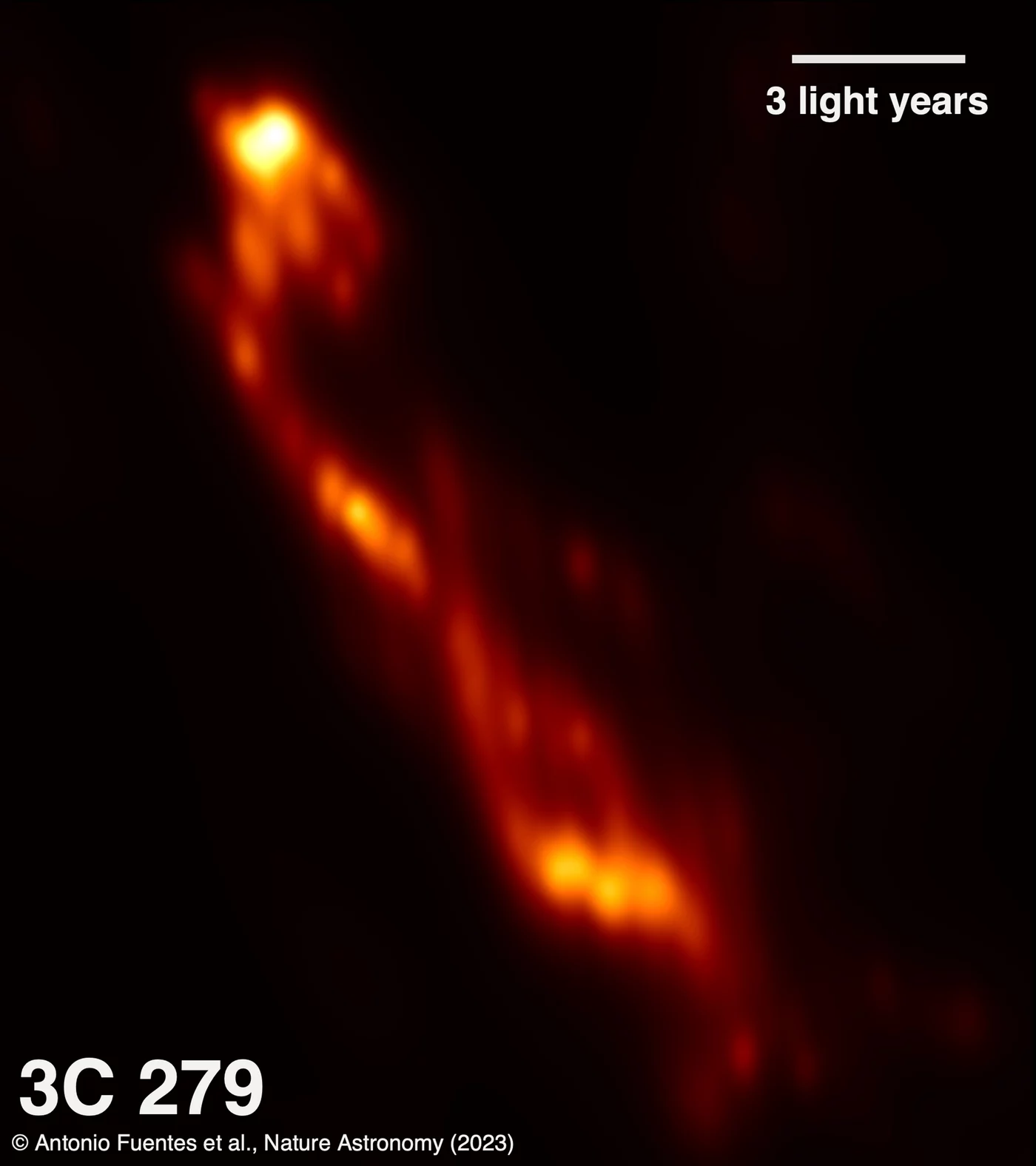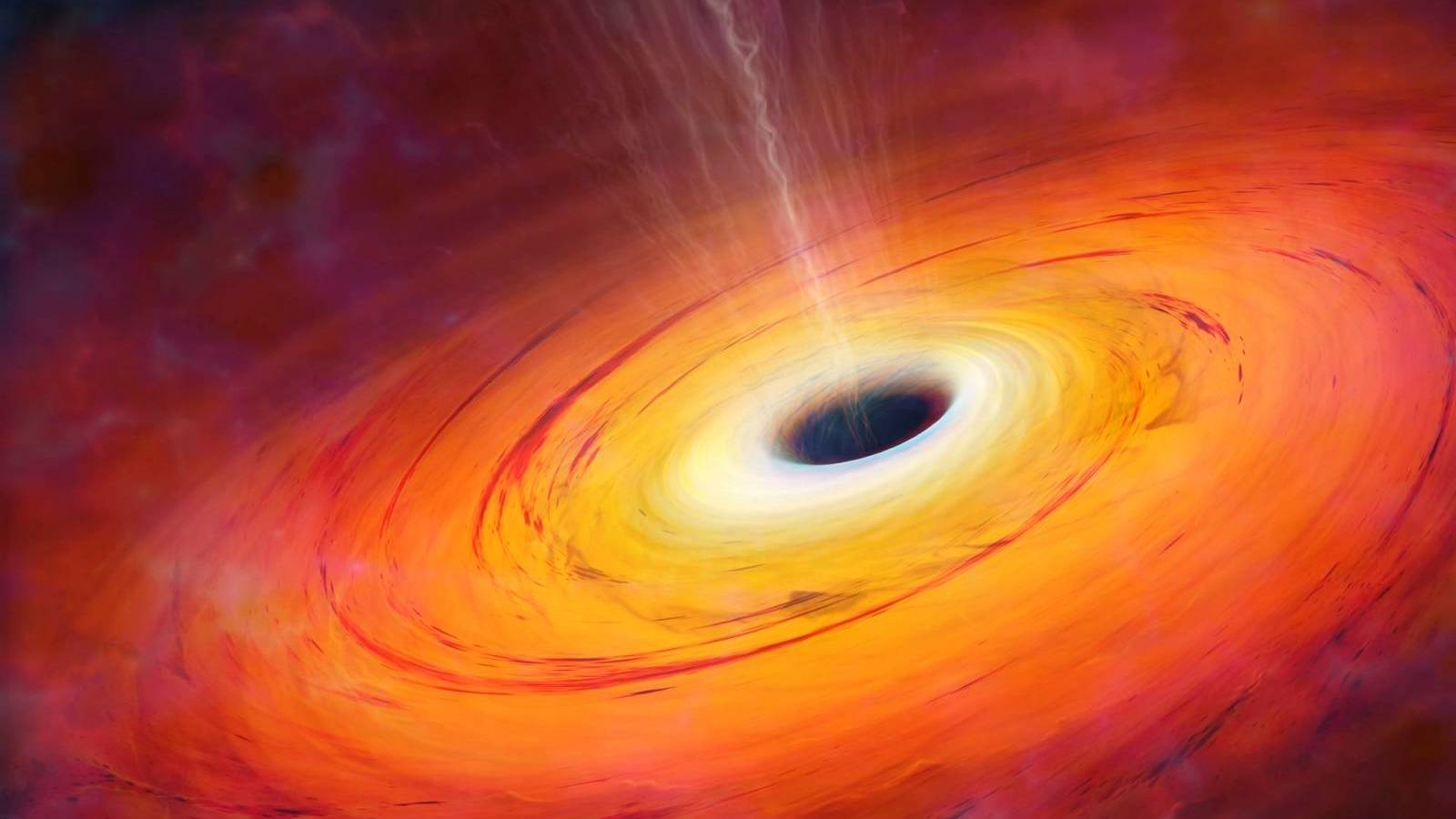Un jet răsucit de plasmă, lung de 570 de ani-lumină, este expulzat dintr-un blazar îndepărtat cu o viteză aproape egală cu cea a luminii. Asemenea unui monstruos păianjen cosmic, o gaură neagră supermasivă îndepărtată împletește un jet de plasmă într-o coardă răsucită și îl lansează cu o viteză apropiată de cea a luminii.
Astronomii au fost martori la acest spectacol impresionant cu ajutorul unei rețele de telescoape radio, inclusiv telescopul spațial RadioAstron, care combinate formează o antenă de mărimea Pământului. Mai exact, această rețea a fost focalizată pentru a observa inima unui blazar îndepărtat numit 3C 279.
Aceste observații reprezintă cea mai detaliată privire pe care oamenii de știință au avut-o vreodată asupra unui jet astrofizic care emana dintr-o gaură neagră supermasivă, dezvăluind un model complex și răsucit în apropierea sursei jetului. Această nouă imagine ar putea contesta teoriile acceptate în prezent, care de 40 de ani sunt utilizate pentru a explica modul în care acești jeturi sunt creați și cum evoluează de-a lungul timpului.
“Mulțumită RadioAstron și unei rețele de douăzeci și trei de telescoape radio distribuite pe întregul Pământ, am obținut imaginea cu cea mai înaltă rezoluție a interiorului unui blazar până în prezent, permițându-ne să observăm structura internă a jetului cu un asemenea nivel de detaliu pentru prima dată”, a declarat Antonio Fuentes, liderul echipei și cercetător la Institutul de Astrofizică din Andaluzia (IAA-CSIC). Blazarii, cum ar fi 3C 279, sunt inimile luminoase ale galaxiilor care emit o lumină puternică ca rezultat al găzduirii unei găuri negre supermasive în proces de alimentare. Iată ce înseamnă acest lucru.
Gaura neagră care aruncă plasmă în univers, uimește

Găurile negre supermasive care se alimentează activ în centrele galaxiilor amestecă continuu materia de care se hrănesc, iar acest material este situat sub formă de discuri aplatizate de gaz și praf în jurul golurilor. Aceste discuri sunt numite “discuri de acreție”. În ansamblu, astfel de scenarii sunt cunoscute colectiv sub numele de nuclee galactice active. Nucleele galactice active sunt adesea atât de luminoase încât strălucesc mai puternic decât lumina combinată a tuturor stelelor din galaxiile înconjurătoare.
Dar aproximativ 10% din nucleele galactice active emit jeturi astrofizice în timpul întregului proces de alimentare. Acestea sunt cunoscute sub numele de cuasari – și când acești cuasari au jeturi îndreptate direct spre Pământ, sunt numiți blazari.
Noile observații ale 3C 279 dezvăluie detalii fără precedent ale jetului de plasmă și ale găurii negre supermasive din inima acestui blazar. “Aceasta este prima dată când vedem astfel de filamente atât de aproape de originea jetului, și ele ne spun mai multe despre cum gaura neagră modelează plasma”, a declarat Eduardo Ros, un alt membru al echipei și coordonator european al Rețelei Globale mm-VLBI Array. “Acest lucru arată cum telescoape diferite pot dezvălui caracteristici diferite ale aceluiași obiect.”
În mod special, echipa a descoperit că jetul este compus din cel puțin două filamente răsucite de plasmă care se întind pe peste 570 de ani-lumină de la sursa lor. Observațiile au arătat de asemenea că jeturile de plasmă nu sunt drepte și uniforme; ele prezintă răsuciri și întoarceri care apar ca rezultat al influenței găurii negre centrale, ceea ce implică faptul că teoriile anterioare despre modul în care evoluează acești jeturi ar putea necesita revizuire. Această cercetare ar putea, de asemenea, să revizuiască înțelegerea noastră despre rolul câmpurilor magnetice în formarea inițială a jeturilor cu viteze apropiate de cea a luminii din nucleele galactice active.
“Un aspect deosebit de intrigant care rezultă din rezultatele noastre este acela că ele sugerează prezența unui câmp magnetic elicoidal care confine jetul”, a declarat Guang-Yao Zhao, unul dintre membrii echipei și cercetător la Institutul Max Planck pentru Radioastronomie. “Prin urmare, ar putea fi câmpul magnetic, care se rotește în sens orar în jurul jetului în 3C 279, cel care dirijează și ghidează plasma jetului care se mișcă cu o viteză de 0,997 ori viteza luminii.”






















